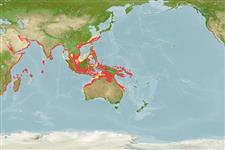Environment: milieu / climate zone / depth range / distribution range
Ecology
Marine; pelagic-neritic; depth range 0 - 150 m (Ref. 30573). Tropical; 30°N - 30°S, 30°E - 162°E
Indo-West Pacific: tropical, widespread. Questionably occurring in the Mascarenes (Ref. 33390). Distribution is probably similar to that of Chirocentrus dorab but not always distinguished from that species (Ref. 188).
Size / Weight / Age
Maturity: Lm ? range ? - ? cm
Max length : 100.0 cm SL male/unsexed; (Ref. 188); max. published weight: 410.00 g (Ref. 4883)
Diagnosis: The slightly longer pectoral fin, 13-18% of standard length, and the absence of black markings on the dorsal fin tip are the only satisfactory characters separating this species from Chirocentrus dorab; also there is no black on the anterior part of the anal fin (Ref. 188).
Pelagic in coastal waters, from the shore to a depth of about 150 m (Ref. 30573). It feeds on small fish and crustaceans (Ref. 5213, 30573). Marketed fresh or frozen.
Life cycle and mating behavior
Maturities | Reproduction | Spawnings | Egg(s) | Fecundities | Larvae
Whitehead, P.J.P., 1985. FAO Species Catalogue. Vol. 7. Clupeoid fishes of the world (suborder Clupeoidei). An annotated and illustrated catalogue of the herrings, sardines, pilchards, sprats, shads, anchovies and wolf-herrings. FAO Fish. Synop. 125(7/1):1-303. Rome: FAO. (Ref. 188)
IUCN Red List Status (Ref. 130435)
Threat to humans
Harmless
Human uses
Fisheries: highly commercial
Tools
Special reports
Download XML
Internet sources
Estimates based on models
Preferred temperature (Ref.
123201): 24.3 - 29.1, mean 28 °C (based on 2510 cells).
Phylogenetic diversity index (Ref.
82804): PD
50 = 1.0000 [Uniqueness, from 0.5 = low to 2.0 = high].
Bayesian length-weight: a=0.00575 (0.00294 - 0.01127), b=3.00 (2.82 - 3.18), in cm total length, based on LWR estimates for this species & (Sub)family-body (Ref.
93245).
Trophic level (Ref.
69278): 4.2 ±0.74 se; based on food items.
Generation time: 4.5 ( na - na) years. Estimated as median ln(3)/K based on 1
growth studies.
Resilience (Ref.
120179): Medium, minimum population doubling time 1.4 - 4.4 years (K=0.24).
Prior r = 0.58, 95% CL = 0.38 - 0.87, Based on 2 data-limited stock assessments.
Fishing Vulnerability (Ref.
59153): Moderate to high vulnerability (53 of 100).
Climate Vulnerability (Ref.
125649): High vulnerability (64 of 100).
Nutrients (Ref.
124155): Calcium = 71.8 [44.0, 193.6] mg/100g; Iron = 1.12 [0.65, 1.96] mg/100g; Protein = 19.6 [17.0, 21.8] %; Omega3 = 0.226 [0.112, 0.461] g/100g; Selenium = 72.6 [35.6, 167.3] μg/100g; VitaminA = 18.4 [6.1, 50.9] μg/100g; Zinc = 0.79 [0.54, 1.13] mg/100g (wet weight);
